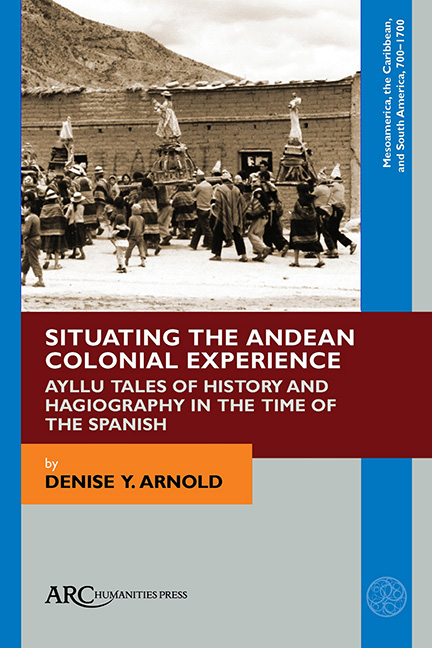 Situating the Andean Colonial Experience
Situating the Andean Colonial Experience Book contents
- Frontmatter
- Contents
- List of Illustrations
- Note About the Spelling of Toponyms and Proper Names
- Acknowledgements
- Maps
- Introduction
- PART ONE THE ORAL HISTORY OF QAQACHAKA
- PART TWO THE COLONIAL CACIQUES IN ORAL AND WRITTEN HISTORY
- PART THREE QAQACHAKA MARKA
- PART FOUR THE SAINTS APPEAR
- PART FIVE THE RELIGIOUS PRACTICES OF QAQACHAKA MARKA
- Some Conclusions
- Glossary
- Appendix A Document C of Don Franco Quispe Maraza
- Appendix B Document K of Don Franco Quispe Maraza
- Bibliography
- Thematic Index
- Index of Toponyms
Chapter 9 - Tata Quri, “Father Gold”
Published online by Cambridge University Press: 22 June 2021
- Frontmatter
- Contents
- List of Illustrations
- Note About the Spelling of Toponyms and Proper Names
- Acknowledgements
- Maps
- Introduction
- PART ONE THE ORAL HISTORY OF QAQACHAKA
- PART TWO THE COLONIAL CACIQUES IN ORAL AND WRITTEN HISTORY
- PART THREE QAQACHAKA MARKA
- PART FOUR THE SAINTS APPEAR
- PART FIVE THE RELIGIOUS PRACTICES OF QAQACHAKA MARKA
- Some Conclusions
- Glossary
- Appendix A Document C of Don Franco Quispe Maraza
- Appendix B Document K of Don Franco Quispe Maraza
- Bibliography
- Thematic Index
- Index of Toponyms
Summary
Tata Quri is very demanding …
Don Enrique Espejo, from Qaqachaka puebloIN OUR GENERAL enquiries about the religious practices of the past, the consensus of opinion among the Qaqachakas was that, before adoring the ayllu saints as they do now, people used to adore the celestial bodies.
Don Domingo Inca Maraza records that his grandfather Bonifacio explained to him, when he was a boy, how people adored the stars in a similar way, observing them from the mountains. The saints came afterwards and were not considered with such seriousness because they were made by human hands, and from crude materials:
My grandfather advised me about this. I don't think he advised me falsely; it must be true. They made libations to the stars. They made blood offerings (wilancha). They say they made the blood offerings while they were watching them (the stars) … For example, they made the blood offerings to the Southern Cross (Kurusir warawara) in Cruz (May) and in Candlemas (in early February). They mentioned the stars and the mountain, and the apacheta (a cairn on a mountain pass) where I live. Apacheta Pillarasi is nearby. You can both go up there. It's quite messy, covered in stones. Well, they drank a lot on that hillside. You go up to that hillside from my house, from there. They say “Pillarasi, Pillarasi.” They talk this way even in the valleys, “Pillarasi, Pillarasi, Quliwasa, Anris Tawayu, Pillarasi Turitu …” They name a bull “Andrés Tamayo Torito.”
Only afterwards came those they called “feast sponsors,” and they got those people called “artists” and some others who knew how to make things out of clay, to mould (the saints) … Those saints were made from clay:
“You’ve made them by looking at them, so now address them. Ask things of God. This is Santiago, this is San Juan …”
They say they made those long afterwards. By pasting clay over cactuses wrapped up in old foodsacks … They were covered in clay. “That's all it is,” they say. My grandfather used to tell me, “Those are just different. One or another of them are just that, those saints,” he said.
- Type
- Chapter
- Information
- Situating the Andean Colonial ExperienceAyllu Tales of History and Hagiography in the Time of the Spanish, pp. 185 - 202Publisher: Amsterdam University PressPrint publication year: 2021
